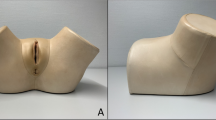Abstract
The pelvic organ prolapse quantification (POPQ) system is currently the most common and specific system describing different prolapse stages. Nevertheless, its use is not yet accepted worldwide in routine care. Our aim was to develop a simple teaching tool for the POPQ system capable of simulating different stages of uterovaginal prolapse for use in medical education with hands on training. We constructed a moveable and flexible tool with an inverted Santa Claus’ cap, which simulated the vaginal cuff and the tassel at the end representing the cervix. A wooden embroidery frame fixed the cap and served as the hymen, the reference point for all measurements. Inside the cap, we sewed buttons to define the anatomic landmark points Aa and Ap located 3 cm distal from the frame. After explaining the device to the students, we used the three-by-three grid for recording the quantitative description of the pelvic organ support. First, each student had to demonstrate a specific prolapse with his cap device. Then, a prolapse was simulated on the cap, and the student had to take the relevant measurements and record them in the POPQ grid. The main training effect to understand the POPQ system seems to be the possibility for each trainee to simulate a three-dimensional prolapse with this flexible vagina model.



Similar content being viewed by others

References
Bump RC et al (1996) The standardization of terminology of female pelvic organ prolapse and pelvic floor dysfunction. Am J Obstet Gynecol 175:10–17
Muir TW, Stepp KJ, Barber MD (2003) Adoption of the pelvic organ prolapse quantification system in peer-reviewed literature. Am J Obstet Gynecol 189(6):1632–1635, Dec
Davila GW, Goniem GM, Kapoor DS, Contreras-Ortiz O (2002) Pelvic floor dysfunction management practice pattern: a survey of members of the International Urogynecological Association. Int Urogynecol J Pelvic Floor Dysfunct 13(5):319–325
Auwald W, Freeman RM, Swift S (2004) Is the pelvic organ prolapse quantification system (POPQ) being used? A survey of members of the International Continence Society (ICS) and the American Urogynecologic Society (AUGS). Int Urogynecol J Pelvic Floor Dysfunct 15(5):324–327, Sep–Oct
Reeves KO, Young AE, Kaufman RH (1999) A simple, inexpensive device for teaching the loop electrosurgical excision procedure. Obstet Gynecol 94:474–475
Ulloth JK (2003) Guidelines for development and implementing humor in nursing classrooms. J Nurs Educ 42(1):35–37, Jan
Chauvet S, Hofmeyer A (2006) Humor as a facilitative style in problem-based learning environments for nursing students. Nurse Educ Today Jul 11; (in press)
Author information
Authors and Affiliations
Corresponding author
Rights and permissions
About this article
Cite this article
Geiss, I.M., Riss, P.A., Hanzal, E. et al. A simple teaching tool for training the pelvic organ prolapse quantification system. Int Urogynecol J 18, 1003–1005 (2007). https://doi.org/10.1007/s00192-006-0276-6
Received:
Accepted:
Published:
Issue Date:
DOI: https://doi.org/10.1007/s00192-006-0276-6



